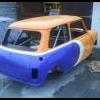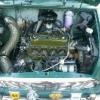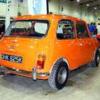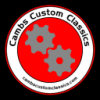
Inner Wings
#1

Posted 21 March 2010 - 12:46 PM
thinking for removing them but still retaining the fixed steel front panel and wings, use brace bars as per a flip front and have removable alloy inner wings to aid engine / clutch changers.
#2

Posted 21 March 2010 - 01:01 PM
#3

Posted 21 March 2010 - 05:11 PM
Chances of passing an iva i recon are nil know what vosa can be like
dave
#4

Posted 21 March 2010 - 05:40 PM
#5

Posted 21 March 2010 - 05:51 PM
Not saying you cant, or can just from the garage i use for mot's and have done for some years, the vosa convesation happened, and vosa consider it a serious modification to monocoque as this is where crash stress it transfered and subframe stress's it requres an IVA from my understanding.
dave
#6

Posted 21 March 2010 - 05:55 PM
#7

Posted 21 March 2010 - 06:25 PM
#8

Posted 21 March 2010 - 06:31 PM
#9

Posted 21 March 2010 - 07:50 PM
any one know what vosa are recommending if these are removed.
#10

Posted 21 March 2010 - 08:37 PM
dave
#11

Posted 21 March 2010 - 08:48 PM
Taken from the Association of Car Enthusiasts website http://www.the-ace.o...dification.html
VOSA Clarification on Body/Chassis points rules
Some of you will have taken the time to find the rules that govern how much you are allowed to modify your vehicle before its identity is called into question.
Whilst the 8 points system has been in place for at least 27 years (in its current form) DVLA have been sadly remiss in making the guidelines relating to car modifying known to those that it affects.
We will shortly be adding articles to show how the system works in relation to various vehicles but this is the description as published by DVLA.
Rebuilt vehicle 8 points system: -
An existing vehicle uses a similar system: -
The guidelines shown above are not specific about their application.
ACE have attempted to clarify certain areas that go to the very root of a car's identity, and how much you are allowed to modify the chassis or monococque, before you lose the 5 points it represents.
We have been liasing with both DVLA and VOSA to clarify this area.
Initially we received this reply from DVLA:
"When assessing a modified/rebuilt vehicle, DVLA's main interest is to establish whether the original identity has been compromised by the changes made. If a vehicle has been modified from the original manufacturer's specification or if not enough of the original components have been retained in the build, the vehicle identity will change and IVA will be required to register with an alternative registration number.
Due to the very nature of rebuilding or modifying vehicles from their original manufacturer's specification, DVLA assesses each vehicle on its own merits based on the documentary evidence provided and a physical inspection of the vehicle.
The INF 26 information leaflet, and the information given on the website, is issued as a guideline to the registration of rebuilt, radically altered or kit converted vehicles. They are not meant as technical guides. However, both clearly indicate that if modifications are made to the chassis or monocoque bodyshell, or if the build does not include enough original, major components (as listed) the identity of the vehicle will change.
The information on www.direct.gov.uk is regularly reviewed to reflect changes in legislation
VOSA have provided the following response to your questions;
Chassis.
Q) What is classed as chassis? Is it purely the outer longitudinal rails or are the crossmembers between these also a part of the chassis?
A) Chassis should be taken to include crossmembers.
Q) We know that cutting or shortening a chassis is classed as modification but is this relative to the vehicle wheelbase i.e. the chassis must remain uncut between the 2 axles but anything forward of front or aft of rear suspension mounts can be removed?
A) Chassis includes the full original length of the longitudinal members including to the front of the front axle and to the rear of the rear axle.
Q) Is it acceptable to remove bodymounts, which contribute no strength to the chassis when changing a body to a different style /make?
A) Yes, providing they are additional to and are not an integral part of the chassis structure.
Q) Is it acceptable to strengthen a chassis by the addition of boxing plates a process that involves turning a 3-sided open chassis rail into a fully enclosed 'box' chassis?
A) Yes, providing the original structure remains unchanged.
Monococque.
Q) What is the definition of a monococque ?
A) A design in which body and chassis are all one unit.
Q) Why does cutting into a monococque affect the vehicle identity if it retains the same shape /profile as before.
A) Cutting is considered to be modifying the vehicle from its original specification. Any modification to the chassis/monocoque body is considered to render the vehicle no longer original specification or of original identity.
Q) Is it acceptable to modify a vehicle bulkhead and/or transmission tunnel when performing an engine change or fitting another make?
A) No, Assuming this is in relation to a monocoque structure. This would be considered a modification to the structure.
Q) Is it acceptable to fully weld sections that are spot-welded as part of the original construction methods, to increase the strength of the body?
A) Yes, providing the original structure is retained.
ACE felt that further clarification was needed from VOSA so we sent more questions.
The following responses are from the VOSA Press Office:-
The answers to our chassied vehicle rules queries seem mainly straightforward, However, we have further questions based on the answers supplied.
Q) As chassis strengthening is allowed, are we correct in assuming that additional crossmembers would also be allowed?
A) It is important that the original chassis structure is retained unmodified, and while it is acceptable to strengthen areas and include additional brackets or crossmembers, It would be limited to additions within the existing chassis frame structure. Additional chassis structures, i.e. extending the outward parameters of the original chassis structure would be considered a modification.
Q) It is the monococque rules that need the most clarification.
Your reply states that any cutting of the monococque" is considered to render the vehicle identity no longer original specification or of original identity ". This would suggest that any crash repairs necessitating cutting and removal of panels or chassis sections, or restoration work would call the vehicle's identity into question?
We presume that the point should really be that any cutting... other than in factory designed joining areas...would be the actual criteria?
A) In this respect it is necessary to differentiate between modification and repair. Any repair process that is in line with manufacturer's recommendations and that returns the structure to its original specification would not be considered to be a modification.
Q) Would the modification of wings to allow clearance for larger wheels fall foul of the regulations?
We presume not as the common fitment of sunroofs does not create issues as this is a non stressed item of the monococque, the same as wings?"
A) When considering a monocoque structure, it is necessary to consider what constitutes cosmetic panels that do not significantly add to the structural strength and which panels provide structural integrity. In general front wings modified in this way would not constitute a modification to the monocoque structure.
With reference to the further query, VOSA have advised that they would prefer the following statement:
What constitutes a monocoque is that of how an OEM manufacturer would view it. The chassis or `cage` assembly and all components that form it, less any cosmetic panels or infills that make no structural consideration to the monocoque or its component parts.
However, we must emphasis that this information is given for general guidance and each case will be judged on its merits.
Whilst none of this is definitive, and it contains the usual 'Judged on it's own merits' criteria, it does answer a lot of questions where the modifier has only been able to speculate in the past.
It means we are aware of what we can or cannot do and still retain the 5 points from the start of any modification process.
So, to summarise the above information:
Chassis
It is acceptable to box original chassis and also to add additional crossmembers but not to alter the existing chassis in any way to allow for their installation.
It is acceptable to remove NON STRUCTURAL body mounts and engine / gearbox mounts.
It is NOT acceptable to shorten, or lengthen the chassis, either in between standard suspension points or fore and aft of these.
Any additional items welded creating a longer overall chassis are classed as modifications. It would however be acceptable to bolt a reasonably sized additional subframe to existing mounting holes.
Any outriggers (as opposed to continuous chassis frame) fore or aft from the chassis would need clarification from VOSA as to their purpose before removal or alteration was accepted. This would be based on their purpose and whether they formed part of the vehicles original Type Approval.
Monococques
It is NOT acceptable for the bulkhead, or transmission tunnel area, to be modified.
The specification for a monococque will vary with each manufacturer and the decision on what are acceptable modifications will be based on those criteria for each vehicle.
It is acceptable for additional seam welding to be carried out.
Should there be any further questions relating the above information on specific vehicles ACE would be willing to assist in further clarification on an individual basis.
The above information relates to only 5 points (awarded for original unmodified chassis / monococque) of the 8 points system for retaining vehicle identity and we will be clarifying other sections in the future.
15/02/2010 Update - VW Beetle Floorpans
We have received a further update from DVLA that they have firmed up their rules and, contrary to previous belief that a VW Beetle's identity lay in it's backbone alone, the floorpans are, in fact, now needed to retain the 5 points.
As before , the requirement that the backbone remains unaltered still applies.
#12

Posted 21 March 2010 - 08:55 PM
Ok, This is what our contact at VOSA has to say about flip fronts in general, with a bit specifically about the Mini
There isn't a blanket yes or no on flip fronts.
If the car has an inner bowl welded to the arch then it IS structural ,if however it is 'open' , then the outer wing is considered not part of the structure.
However it is a matter of what else is chopped away or incorporated into the flip front .
On Mini, the wings and bonnet are fine, anything else isn't.
If the bonnet and wings are one piece and that flips then you're OK providing that the inner wing stays connected and is not cut out.
Cut the inner wing out and replace it with stay bays and that becomes a monocoque mod.
How practical this is I don't know because I don't know Minis all that well.
I've just gone back to the team for further clarification and the way it stands is this.
The inner wing should remain structurally sound as it serves the same purpose as the stay bar but is the ORIGINAL OEM and any holes MAY become an issue due to the structure being considered borderline on strenth by VOSA with the front flipping .
So, provided the inner wings are kept intact and un-modified, a flip front should not be classed as a monocoque mod.
#13

Posted 21 March 2010 - 09:05 PM
All this tells me is that VOS do not want the inner wings removed for vehicle ID reasons only, as the vin/chassis plate is located there!!!
Does that mean cars that are pre ???? that don't need to display a chassis number would not have a problem?
#14

Posted 21 March 2010 - 09:07 PM
its seems like the msa rule book, if it dont say you can do it, then persume you cant.
dave
#15

Posted 21 March 2010 - 09:26 PM

1 user(s) are reading this topic
0 members, 1 guests, 0 anonymous users

















